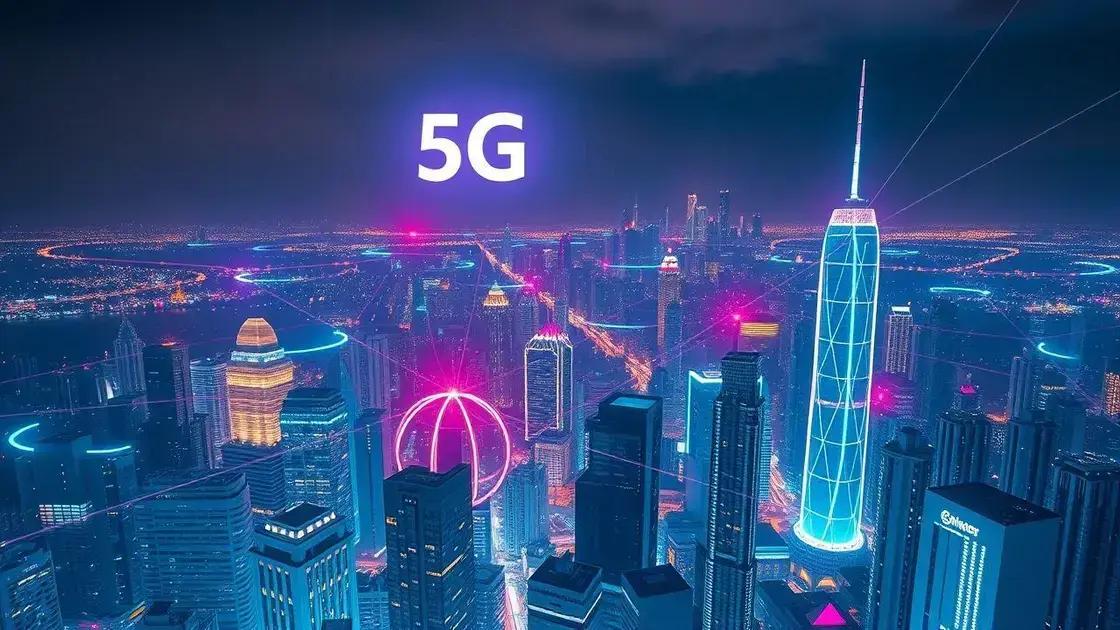5G technology rollout: transforming connectivity today

Anúncios
5G technology rollout offers faster speeds, lower latency, and improved connectivity for various industries, revolutionizing how we interact with smart devices, enhancing healthcare, and fostering innovations in telecommunications and transportation.
5G technology rollout is changing the landscape of connectivity as we know it. Imagine lightning-fast internet speeds transforming everything from healthcare to entertainment. Curious about how this affects you and your daily life?
Anúncios
Understanding 5G technology and its benefits
Understanding 5G technology is essential as it represents a significant leap in mobile connectivity. This new generation of wireless communication offers remarkable improvements over previous technologies. With its implementation, users can expect greater speeds, lower latency, and a larger capacity for connected devices.
Key Features of 5G Technology
5G technology brings several innovative features:
Anúncios
- Incredible data transfer rates, enabling faster downloads and streaming.
- Reduced latency, which improves real-time communication.
- The ability to connect more devices simultaneously, supporting the growing Internet of Things (IoT).
These features are not just technical enhancements; they have real-world applications that can transform various sectors. For example, in healthcare, 5G can facilitate telemedicine with high-quality video calls, while in transportation, it enables improved communication between vehicles and infrastructure.
Benefits of 5G Technology
The benefits brought by 5G are vast and varied:
- Enhanced user experiences with ultra-high-definition streaming.
- Increased reliability for critical applications, like emergency services.
- Boosted economic growth as industries leverage new technologies.
Overall, the impact of 5G technology extends beyond just faster internet speeds. It opens avenues for innovation, allowing industries to evolve and adapt to new challenges. As we look ahead, understanding these benefits is crucial for individuals and businesses alike, ensuring they can take full advantage of this transformative technology.
Current status of 5G technology rollout
The current status of 5G technology rollout reflects significant progress and expansion across the globe. Many countries have been actively working to enhance their mobile networks to provide faster and more reliable services. As technology advances, the rollout continues to accelerate, promising a future where connectivity is seamless and impactful.
Global Deployment of 5G
Various nations have made substantial investments in 5G infrastructure. Countries such as the United States, China, and South Korea are leading the way. They have deployed numerous 5G towers and enhanced fiber optic networks to support this new technology.
- The United States has established 5G networks in major cities like New York and Los Angeles.
- China is aggressively expanding its 5G coverage, aiming for comprehensive national service.
- South Korea has integrated 5G across various aspects of its economy and daily life.
In addition to these leaders, several other nations are catching up rapidly. Europe, India, and parts of Southeast Asia are also rolling out their networks to enhance connectivity options for users.
Adoption Rates and Challenges
Despite the rapid expansion, 5G adoption faces several challenges. While many consumers are excited about the faster speeds, some areas lack access to the necessary infrastructure. Rural regions often struggle to receive updates, which can slow down their adoption rates.
Moreover, the cost of implementation can be high. Telecom companies are investing heavily in new technologies and equipment, which may affect service pricing for consumers in the short term. However, as the rollout matures, prices are expected to stabilize, making 5G more accessible.
Key industries impacted by 5G

The impact of 5G technology extends across various industries, transforming how they operate and deliver services. As businesses adopt this advanced connectivity, several key sectors are experiencing significant changes that enhance efficiency and innovation.
Telecommunications
The telecommunications industry is the backbone of 5G deployment. Service providers are expanding their networks to offer faster speeds and reduced latency. This improvement allows for better voice and video calls, which enhances customer experience.
- Higher bandwidth for streaming services.
- Improved connection for remote work technologies.
- Seamless communication between devices.
These advancements ensure users can rely on their services for essential daily functions, both professionally and personally.
Healthcare
The healthcare sector also benefits greatly from 5G technology. With faster data transmission, healthcare providers can improve patient care dramatically. Remote care and telemedicine are being revolutionized, enabling doctors to diagnose and treat patients from anywhere in the world.
- Real-time monitoring of patient vitals.
- Remote surgeries with minimal latency.
- Improved access to healthcare resources in rural areas.
This allows quicker responses in emergency situations and enhances overall healthcare accessibility.
Automotive
In the automotive industry, 5G technology is paving the way for smart vehicles and autonomous driving. With the ability to transmit large amounts of data swiftly, vehicles can communicate with each other and roadside infrastructure effectively.
This connectivity ensures:
- Safer navigation through real-time traffic updates.
- Enhanced driver assistance technologies.
- Integration with smart city systems for better traffic management.
As these vehicles become more connected, the potential for smart transportation systems grows, making travel safer and more efficient.
Overall, the adoption of 5G across various industries is driving innovation and creating new opportunities for businesses and consumers alike. The future holds exciting possibilities as technology continues to advance, reshaping our world in profound ways.
Challenges in the 5G rollout process
The rollout of 5G technology comes with several challenges that can slow down its implementation. While the potential benefits are vast, addressing these issues is crucial for successful deployment.
Infrastructure Requirements
One of the main challenges is the need for extensive infrastructure upgrades. Unlike previous generations, 5G requires a denser network of antennas and small cell deployments. This infrastructure must be installed in urban and rural areas alike.
- Many existing structures are not equipped to handle the new technology.
- The installation process can be time-consuming and costly.
- Local regulations can complicate the approval process for new towers.
As communities grow, building this network is essential to ensure that everyone has access to high-quality service.
Cost of Deployment
The financial investment needed to deploy 5G is another significant hurdle. Telecommunications companies must allocate substantial funds for equipment and labor. This cost can lead to higher prices for consumers in the short term.
Additionally, smaller companies may struggle to compete with larger corporations that have more resources for investment. This can create a gap in service availability, particularly in underserved regions.
Regulatory Challenges
Government regulations can present another barrier. Each region may have different rules regarding the installation of telecom infrastructure. Navigating these laws can delay the rollout process significantly.
Moreover, public concerns about health issues related to radiation from 5G towers can lead to opposition in communities, making the approval process more complicated.
Public Awareness and Adoption
Finally, consumer awareness plays a vital role in the transition to 5G. Many users are unfamiliar with the benefits and functions of this new technology. As a result, they may not see the value in transitioning from their current services.
Educational initiatives can help bridge this gap. Informing the public about the advantages of 5G is essential for widespread adoption and utilization.
Future prospects of 5G technology
The future prospects of 5G technology look bright, with many exciting possibilities that can transform our daily lives and industries. As this technology continues to evolve, it will shape how we interact with the digital world.
Enhanced Connectivity
One significant advantage of 5G is enhanced connectivity. As more devices become connected through the Internet of Things (IoT), the demand for robust networks will increase. 5G will make it easier for smart devices to communicate seamlessly, leading to smarter homes and cities.
- Integration of smart appliances that interact with users.
- Development of smart traffic systems to reduce congestion.
- Increased reliability of connected healthcare devices.
The potential for efficiency improvements in various sectors can revolutionize how we live and work.
Innovations in Technology
5G is not just about faster internet; it also enables innovation in other technologies. With 5G, advancements in areas like artificial intelligence (AI) and augmented reality (AR) will become more mainstream. These technologies require high-speed connections for real-time data processing and interaction.
Examples include:
- AI applications that improve decision-making in business.
- AR technologies that enhance training and experiential learning.
- Virtual reality solutions for entertainment and immersive experiences.
These innovations will create new markets and employment opportunities, fostering economic growth worldwide.
Expansion of Mobile Services
As 5G technology expands, mobile services will also diversify. We can expect more advanced mobile applications that utilize the speed and capacity of 5G. This expansion will lead to improved services in areas such as:
- Gaming, with lower latency and higher performance.
- Streaming, delivering high-quality content on the go.
- Remote work solutions that mimic in-person experiences.
With increased accessibility, more people will benefit from applications and services previously limited to specific locations.
Overall, the future of 5G technology holds promising potentials that can change the landscape of connectivity, innovation, and services in our lives. As more investments pour into this technology, we can expect to see these advancements materialize and enhance our daily experiences.
FAQ – Frequently Asked Questions about 5G Technology
What advantages does 5G technology offer over previous generations?
5G provides faster speeds, lower latency, and the ability to connect more devices simultaneously, enhancing user experience and enabling new applications.
Which industries will benefit the most from 5G?
Key industries include telecommunications, healthcare, automotive, and entertainment, all of which will see improvements in efficiency and the introduction of innovative services.
What challenges are associated with the rollout of 5G?
Challenges include the need for extensive infrastructure, high deployment costs, regulatory hurdles, and public awareness about the technology.
How can individuals prepare for the transition to 5G?
Individuals can stay informed about the benefits of 5G, explore compatible devices, and consider their internet needs to fully utilize this advanced technology.






